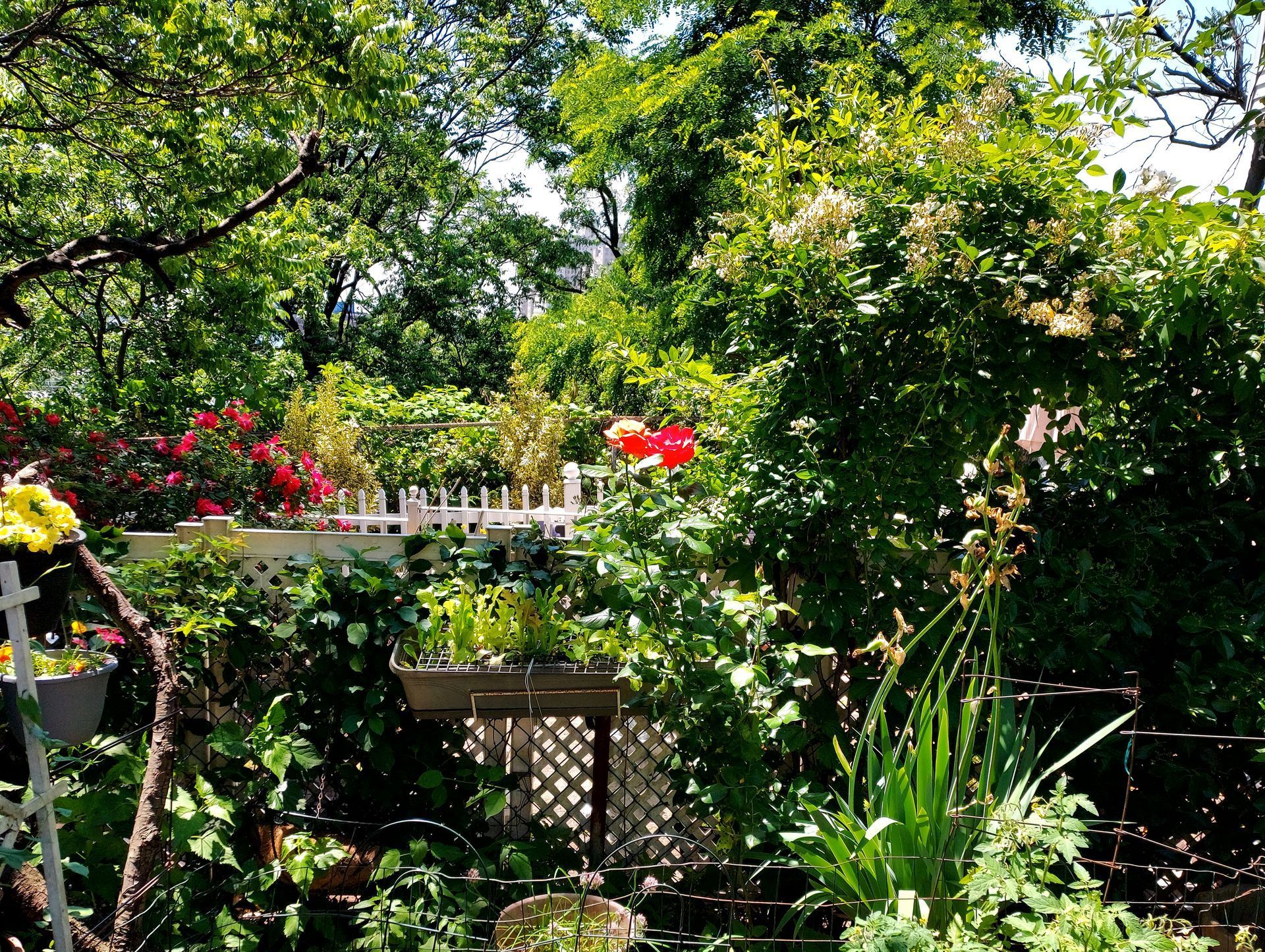
Gardening Articles:
Getting the right amount of light in your city garden
Light is a requirement for growing flowers or vegetables. Growing these in an urban area can be a challenge. Having a garden in a city environment can sometimes mean a balcony, small backyard , courtyard or even just window and fence boxes. The buildings around can start casting shadows as the sun moves through the day. Having a standing garden in one spot means planting according to the amount of light you can expect there.
The location of the garden in an urban area can be critical to its success. You will have to consider the angle of the sun, which can differ as the growing season goes on due to the sun's travel from north to south as fall approaches. Make a chart of the area you want to use and note the number of hours of sun it receives. Shadows cast from buildings, trees, walls, etc. will affect this. Next, determine whether the area receives full sun, partial sun or part shade or full shade. After you have this figured out, pick plants that will thrive with the light conditions you have available. Light requirements are usually listed on the tag for the plant or the seed packet.
Here are a few facts about plants and light:
There are three levels of light when it comes to plant growth:
Full Sun - at least six hours of sun daily (water lilies need this amount of sun to bloom)
Partial Sun/Shade - three to four hours of direct sun
Shade - two hours or less of direct sun or filtered light
In addition to the amount of light, there are wavelengths of light to consider. Light ranges from violet or ultraviolet (shortest wavelength) to red and infrared (longer wavelengths). Photosynthesis evolved to interact optimally with blue and red light. The shorter blue light wavelengths are higher energy than the longer length red light wavelengths. The placement of plants in the garden affects their growth. Sunlight coming in at an angle closer to the horizon has less high energy blue light than sunlight directly overhead. Far red light can cause long, thin stems and trigger flowering.
Growing in containers that can be moved can be a solution to this problem. You can use big pots and buy pot platforms that have wheels on them. This way, the plants (such as tomatoes, basil, etc) that love the sunlight can be rolled to parts of the yard or balcony where the sun is. There are self contained growing units like the Grow Box that come with wheels on the bottom. Fence boxes that are not too heavy can be moved around to parts of the fence that get more light. Planting in moveable containers can be a good solution to getting enough light for your plants in your city garden.
copyright 2023 C.Nissen
Soil in the City Garden
Test your soil or use containers in your city garden.
So, you've got some yard space in back or front of your townhouse or apartment building. It's got adequate sun and you aren't too far from a water source. The soil, however, doesn't look so great. Mixed into the weeds are broken glass and trash. Upon digging, you find that the weeds are so pervasive they almost form a network in the soil. On top of that, you start to wonder what else is in the soil.
You could get the soil tested by sending out a sample to a soil testing lab but that would take time and money. The weather is warm and just right for starting a garden so what do you do? Container gardening is the answer. A container can be anything from a raised bed box of 2' x 2' or larger, to large pots, fence boxes or window boxes. The choice is yours depending on your budget and ability to bring in soil and water. If all you've got is a stoop, try using large pots for cherry tomatoes, herbs and salad greens. Got some fences around the yard space? Use fence boxes for greens, herbs and small vegetables. If all you have to look at is a brick wall, look for a grid system to hang pots or boxes off of.
It is important to have your soil tested or use containers if you want to eat what you grow.
Common urban soil contaminants can be:
leakage from old oil tanks
landfill contaminants
industrial waste
solid/liquid waste seepage
excess pesticides (for rodents, etc)
herbicides (like Round Up)
medical waste
construction materials like paint, thinners, etc.
You get the picture. It's always better to be on the safe side if you are planning on eating what you grow. There are many kits for easy assembly of raised bed boxes. Now, there are more "vertical growing" tools for small urban spaces like the Gro-Box and the Garden Tower. Search online and you can find a solution that fits your space and your budget. Happy city gardening!
copyright 2023 C.Nissen
Small Organic City Gardens
There are real advantages to container and small space gardening in urban areas. Many cities are known more for their brownfields than green ones. Raised beds and container gardening are the best options if you are not sure of the state of the soil or don't have easy access to soil testing. These small raised bed or container gardens can work very well using organic methods of growing.
Here are some basics for a healthy, toxin free garden:
Inspection
of the garden on a daily basis can eliminate disease or infestations before they become a problem. An old Chinese saying is worth remembering - "The best fertilizer in the garden is the gardener’s own shadow." Make your own soap spray combinations to deal with pests (use Ivory, Dr. Bronners, etc.). There are also homemade combinations for fungus and blights using common household ingredients.
Use companion planting methods to help the plant's growth. This is the practice of placing plants like marigolds near some vegetables. Marigolds help repel bugs. Basil plants and tomatoes grow well near each other. Native Americans would plant the "Three Sisters" together. These consist of corn, beans and squash. The corn functions as a support for the beans which add nitrogen to the soil. The squash provides ground cover which helps retain moisture for the corn and beans. Squash with spiny vines and leaves helps protect the corn and beans from pests.
Fertilizer can be as close as your kitchen. Use a small compost container on the counter to contain kitchen scraps. Don’t add meat or dairy products. You can add eggshells, coffee grounds, and vegetable and fruit peelings. This mix can then go outside into a larger receptacle that is turned every so often to aerate it. This will provide a nutrient rich growing medium that can also function as a mulch.
If you have access to a downspout, you can invest in a rain barrel. Just be sure it is covered or put a screen on it to keep mosquitoes from moving in. Rainwater doesn't contain chlorine and plants seem to do better with it. Using rainwater saves money and eliminates the need for lugging water out in a can if you don't have a garden hose. Many rain barrels have an attachment for a small hose.
So, there you have it. Natural pest control, companion planting, composting and use of rainwater are the basics for a healthy, small city garden. A small urban space is a good match for organic methods of growing.
copyright 2023 C.Nissen
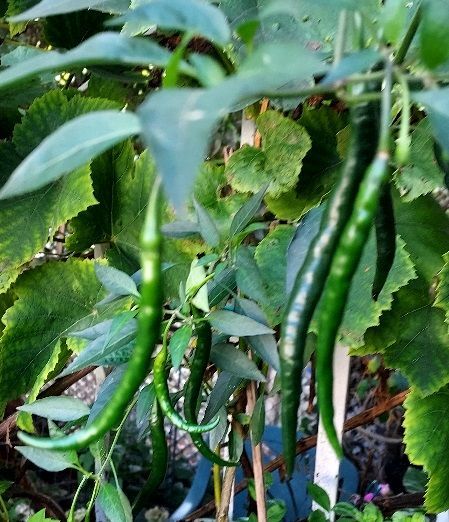
Hot Cayenne Pepper
Hot Cayenne Pepper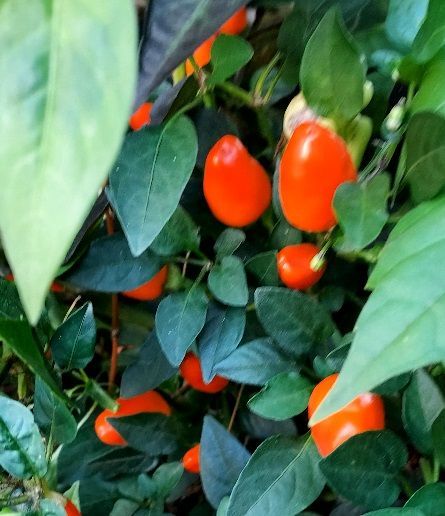
Thai Chili Pepper
Button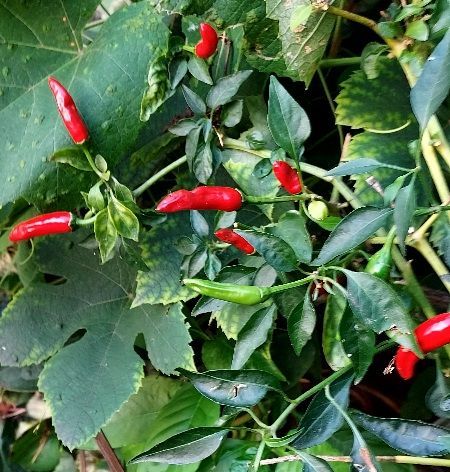
Hot Red Chili Pepper
Button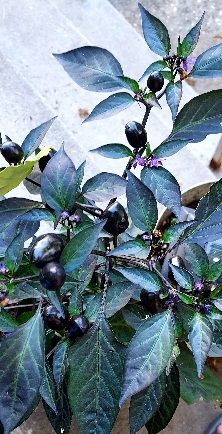
Thai Pepper
Button
August 14, 2023
Peppers in My City Garden JC this year:
Sweet Red Mini Bell Peppers (pictured above)
Thai Chili Peppers
Hot Red Chili Peppers
Thai Hot Peppers (these start out black and turn red)
They have purple flowers which is unusual
Cayenne Peppers (the old standby for hot sauce. )
It only takes a few of these babies to heat up a meal!!
August 19, 2023
What to love about August. Crickets, Peppers, Moon Flowers, Tomatoes, Cucumbers, Cicadas
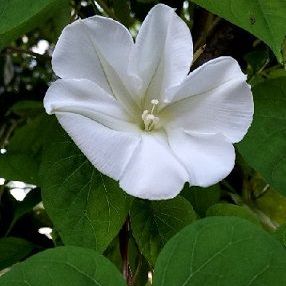
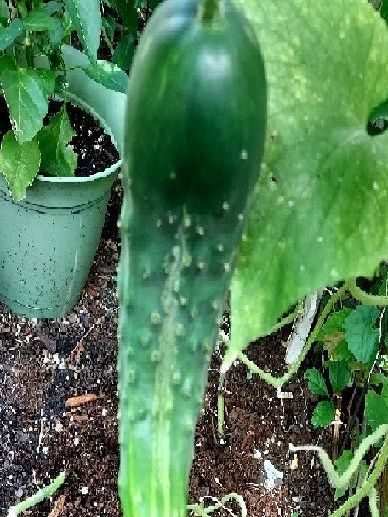
August 29, 2023
In some ways, it's the best part of the summer. The colors tend to gold, red and orange and are just lovely in the sunlight. Veggies are starting to ripen and there are still plenty of flowers. The cooler weather is easier on the flowers which don't do well in the brunt of high heat... Still good crops of cherry tomatoes, basil, rosemary, dill, mesclun mix, pak choy, lettuce. The cukes have been a problem, not very many of them and it seems I'm not the only one w/ that problem. A professor of plant bio I know, said sometimes it's the seeds, sometimes it's the variation of temperatures that affect whether there are cukes.


